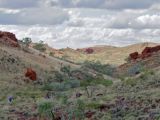Common scientific knowledge has it that, about 2.4 billion years ago, the levels of the chemical oxygen in the Earth's atmosphere began to suddenly climb, until they reached at one point concentrations similar to the ones existent today. The fact that the planet is able to support such a variety of life forms is entirely owed to the fact that we have oxygen in the air. The “Great Oxidation Event” (GOE), as scientists term it, saw a massive rise in the oxygen level, and not just a smooth increase over time. In a new scientific study, however, it has become apparent that the rise in oxygen production predated the GOE by more than 100 million years.
The team behind the new investigation is based at the University of California in Riverside (UCR). “Their findings go a step farther, to demonstrating that even very low concentrations of oxygen can have profound effects on ocean chemistry,” National Science Foundation (NSF) Division of Earth Sciences Program Director Enriqueta Barrera says. The Division was among the main sponsors for the research, alongside the American space agency NASA.
There were until recently only two questions remained unanswered as to the action of oxygen on the early stages of planetary development. The first one was related to when oxygen production began through the process of photosynthesis, while the other was related to establishing when these heightened levels of the chemical began to influence the make-up of the atmosphere and the oceans. Details of the team's research appear in this week's issue of the top journal Science.
“The conventional wisdom has been that appreciable atmospheric oxygen is needed for sulfidic conditions to develop in the ocean. We found, however, that sulfidic conditions in the ocean are possible even when there is very little oxygen, below about 1/100,000th of that in the modern atmosphere,” UCR Earth scientist Chris Reinhard, a research team member, adds. The hydrogen sulfide in the ocean is essentially a fingerprint of photosynthetic production of oxygen, more than 2.5 billion years ago, UCR biogeochemist Timothy Lyons, the leader of the investigation, adds.
“A pre-GOE emergence for oxygenic photosynthesis is a matter of intense debate, and its resolution lies at the heart of understanding the evolution of diverse forms of life. We have found an important piece of that puzzle. Our data point to oxygen-producing photosynthesis long before concentrations of oxygen in the atmosphere were even a tiny fraction of what they are today, suggesting that oxygen-consuming chemical reactions were offsetting much of the production,” Reinhard concludes.

 14 DAY TRIAL //
14 DAY TRIAL // 
